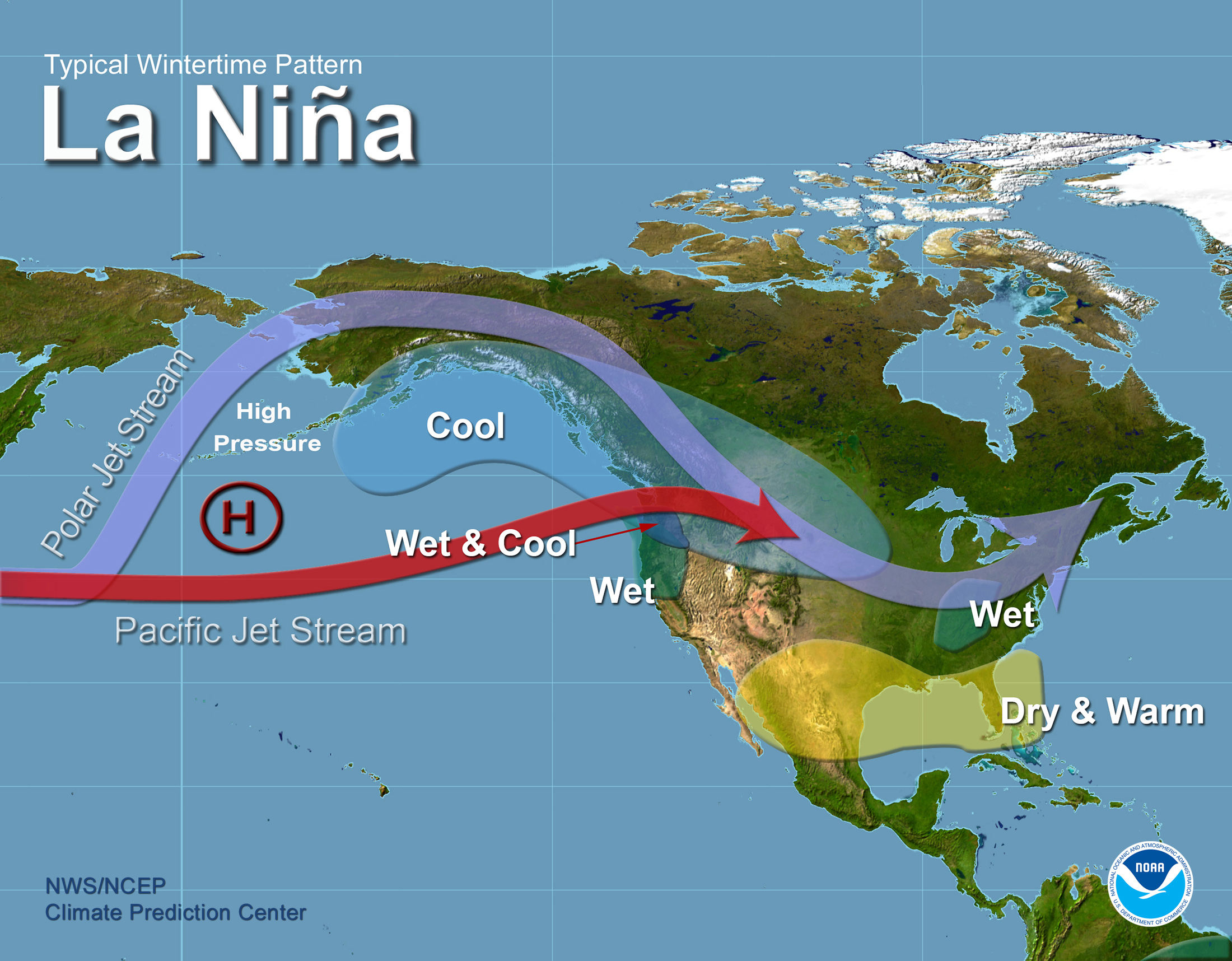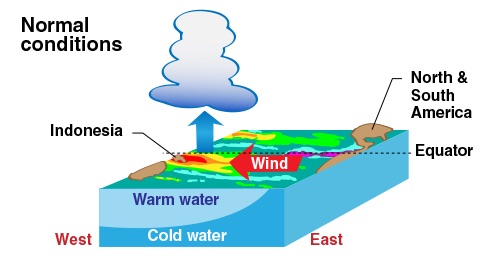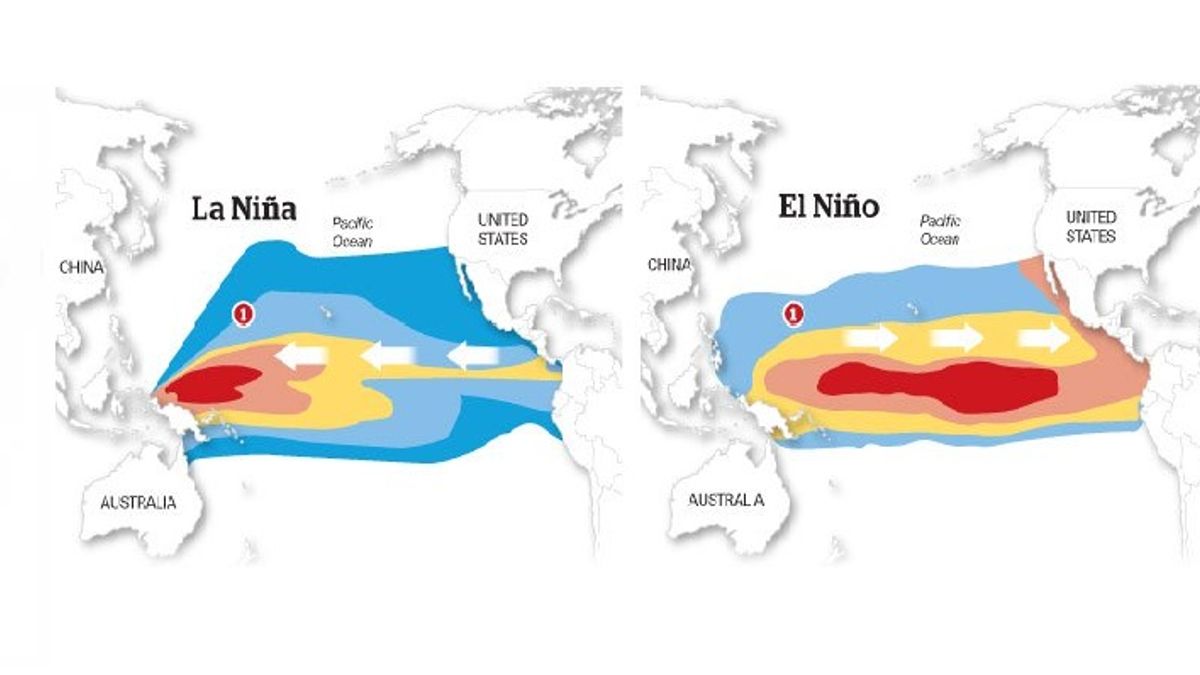What Does A La Nina Weather Pattern Mean
ENSO is a coupled atmosphere-ocean phenomenon which means that the transition between La Niña El Niño and neutral conditions neither El Niño nor La Niña is governed by interactions between the atmosphere and ocean circulation. What does that mean for our weather in Mid-Missouri.

What Is La Nina El Nino Theme Page A Comprehensive Resource
First off what is a La Nina.

What does a la nina weather pattern mean. La Niña and El Niño both deal with warmer or cooler than normal temperatures in the eastern Pacific near the equator. And especially the Southwest La Niña often means drier and warmer weather. The term La Niña describes a particular phase of the ENSO climate cycle.
The experts believe we have a 70 chance of going into a La Nina weather pattern. In this pattern strong winds blow warm water at the oceans surface from South America to Indonesia. La Nina not only affects the United States but weather.
Definition of La Niña. 1970-71 followed by 1971-72. La Niña occurs when cooler than normal temperatures are observed.
La Niña is the the girl child of the Pacific who brings flooding rains. So by that count heres the first year La Nina winters that were followed by La Nina the next winter 8 events total. 1954-55 followed by 1955-56.
The La Niña climate pattern is a natural cycle marked by cooler-than-average ocean water in the central Pacific Ocean. La Niña is a climate pattern that usually delivers more dry days across the southern third of the US. What is La Niña.
La Niña is the cold phase of the El NiñoSouthern Oscillation ENSO cycle. Courtesy of Mike Baker. Its when the waters in the Central Pacific Ocean are cooler than normal.
The Effects of La Niña. A second year La Nina means that there was a La Nina winter events tend to reach their strongest point in the winter months prior to the second winter of La Nina. In a typical La Nina pattern the polar jet stream wraps around a strong blocking high spanning over the northern Pacific to our west.
According to an article on USA Today this will be driving force when it comes to weather for late fall and the winter months of January February and March. As the warm water moves west cold water from the deep rises to the surface near the coast of South America. To strong La Niñas.
For the continental US La Niña typically means a cooler and wetter pattern in the northern half of the country while a drier and warmer pattern sets up in the southern United States. La Niña is a weather pattern that occurs in the Pacific Ocean. An irregularly recurring upwelling of unusually cold water to the ocean surface along the western coast of South America that often occurs following an El Niño and that disrupts typical regional and global weather patterns especially in a manner opposite to that of El Niño.
La Niña Fact Sheet. La Niña is the periodic cooling of the equatorial eastern and central Pacific ocean. For the entire southern third of the US.
These patterns result from colder than normal ocean temperatures inhibiting the formation of. La Niña refers to one phase of the El Niño-Southern Oscillation or ENSO the interaction between the ocean and atmosphere in the tropical Pacific that results in variations in sea surface temperatures air temperatures and precipitation. It is identified by colder than normal water along the equatorial Pacific.
It is one of the main drivers of weather in the United States and around the. The Bureau of Meteorology has declared a La Niña weather event for 2021 meaning much of Australias east and north faces a wet and stormy summer. When a weak La Niña started off 2017 with mainly neutral conditions during hurricane season and now trending back towards La Nina for winter there have been 17 storms - 7 tropical storms and.
While warmer than normal ocean water temperatures are. ENSO episodes typically last 9-12 months and reach their peak strength during late. La Niña is a climate pattern that is directly related to the water temperatures off the west coast of South America near the Equator.
La Nina patterns are the result of the strengthening westerly wind fields from the surface through the mid-layers of the atmosphere that push warm surface water from the eastern to the western Pacific Equatorial basin. It is the opposite of El Niño which is identified by warmer than normal water along the equatorial Pacific. A northwest jet stream pattern has higher chances of below normal precipitation above normal temperatures and periods of strong and gusty downslope winds Chinook and Bora wind events east of the Continental Divide particularly during the autumn and spring of La Niña episodes.
Jenita Enevoldsen For any real keen weather watchers out there there is another ENSO phase called El Niño. When sea-surface temperatures are cooler than average by at least 05 degrees Celsius 09 degrees Fahrenheit. Changes in global atmospheric circulation patterns accompany La Niña and are responsible for weather extremes in various parts of the world that are typically opposite to those associated with El Niño.

What Is La Nina Nasa Space Place Nasa Science For Kids

What Are The Differences Between El Nino And La Nina
Weather Blog La Nina Forecasted For Winter 2020
Posting Komentar untuk "What Does A La Nina Weather Pattern Mean"